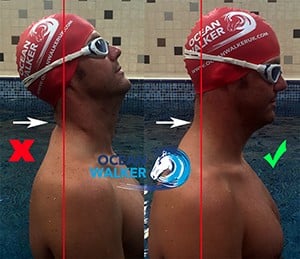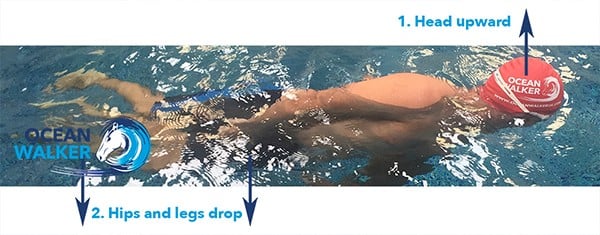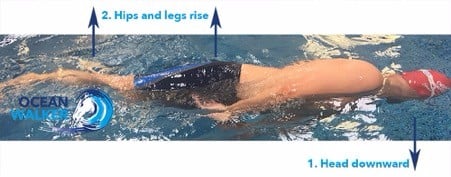Want more power for less effort? This series of freestyle swimming technique articles will help you achieve just that starting with the benefits of keeping a still head when swimming front crawl.
Background
The Ocean Walker swimming stroke technique was created when Adam Walker, (first British person to swim the toughest 7 ocean Swims in the world, known as ‘Oceans 7’) ruptured his bicep tendon after swimming the English Channel and was advised not to swim again by a specialist. It took two operations and was only a partially success leaving two tendons stuck together leaving him still with an issue. As a result, Adam was forced to create a way of swimming in order to prolong his swimming career, which resulted in him swimming 6 more ocean swims and the fastest man in the BDLSA 2 Way Windermere Race in 2011.
“I became very aware of my body position and how it was moving through the water. My initial goal was to find a way to carry on swimming by offloading pressure on the shoulders. A gentle elbow push in conjunction with 180 degree hip rotation not only took pressure off, it created more power for less effort and very quickly in a matter of weeks I was faster, more efficient and using less energy. Saving a whopping 1200 strokes an hour!’
In this series of articles, Adam will dissect the Ocean Walker Technique and provide you with crucial tips in order to swim fast, efficient and injury free for pool and open water swims.
Keeping a still head in freestyle
I never thought about the importance of my head position whilst swimming. My arms would drive forward and my head would often follow the front driving arm. When I started to break it all down without arms, you realise the head acts like a boat rudder and depending on what direction or angle your head is, your body will follow. Your arm strokes can compensate for any head movement to keep yourself in a straight line, but this involves more energy to keep you aligned and increases drag as you are moving your body through more water surface area than necessary and swimming unnecessary extra distance.

The head position is where I begin in all my coaching sessions. Not only should the head be still, you should be looking downward, which is a neutral position. This is the equivalent of looking forward standing up which we all do. If you look up when swimming you will be engaging extra muscles and putting strain on the neck. (I still have nerve issues in my neck caused from my old swimming technique looking up and lifting the head). Over longer distances you will start to feel the strain and potential neck issues. Looking forward in swimming is the equivalent of looking at the sky when on land.
Potential negative effects of head up, eyes looking forward in the water over a long distance
In my case it created pressure on the spine with sinking legs. Makes sense really as the head is the heaviest part of the body, so by looking straight down your head will be more immersed, which will help bring your hip and legs up – it’s physics!
If you want to look far in front of you, this could come at a price of an inefficient body position with legs dropping. This can be compensated with artificial buoyancy from a wetsuit or pull buoy, but remember if you head is high and your feet are at the surface, this can create pressure on your spine. This can lead to injury unless you have good flexibility.

The benefits of head down in the water
You can sight and breathe easily from the downward head position used in the Ocean Walker technique. Eyes just clear the water so there is minimal lifting of the head in order to save energy, reducing stress on the neck and shoulders keeping the hips and legs up in order to keep the body as efficient as possible and reduce drag.

The Medical Perspective
David Pickering (registered Osteopath and qualified Acupuncturist) says “A flat body position places the neck and lower back under strain due to the prone positioning of the body. The neck is held in extension (tipped back) placing stress on the bony and muscular structures at the back of the neck, whilst the low back is often arched with shear forces being placed on the lower spine when the legs are kicked. It is the lower level amateur and “weekend warrior” swimmers who are more susceptible to injuries affecting these areas, owing to generally lower levels of fitness and strength, than club or elite swimmers.”
Freestyle Swimming Technique - High Elbows To Avoid Shoulder Injury -->














